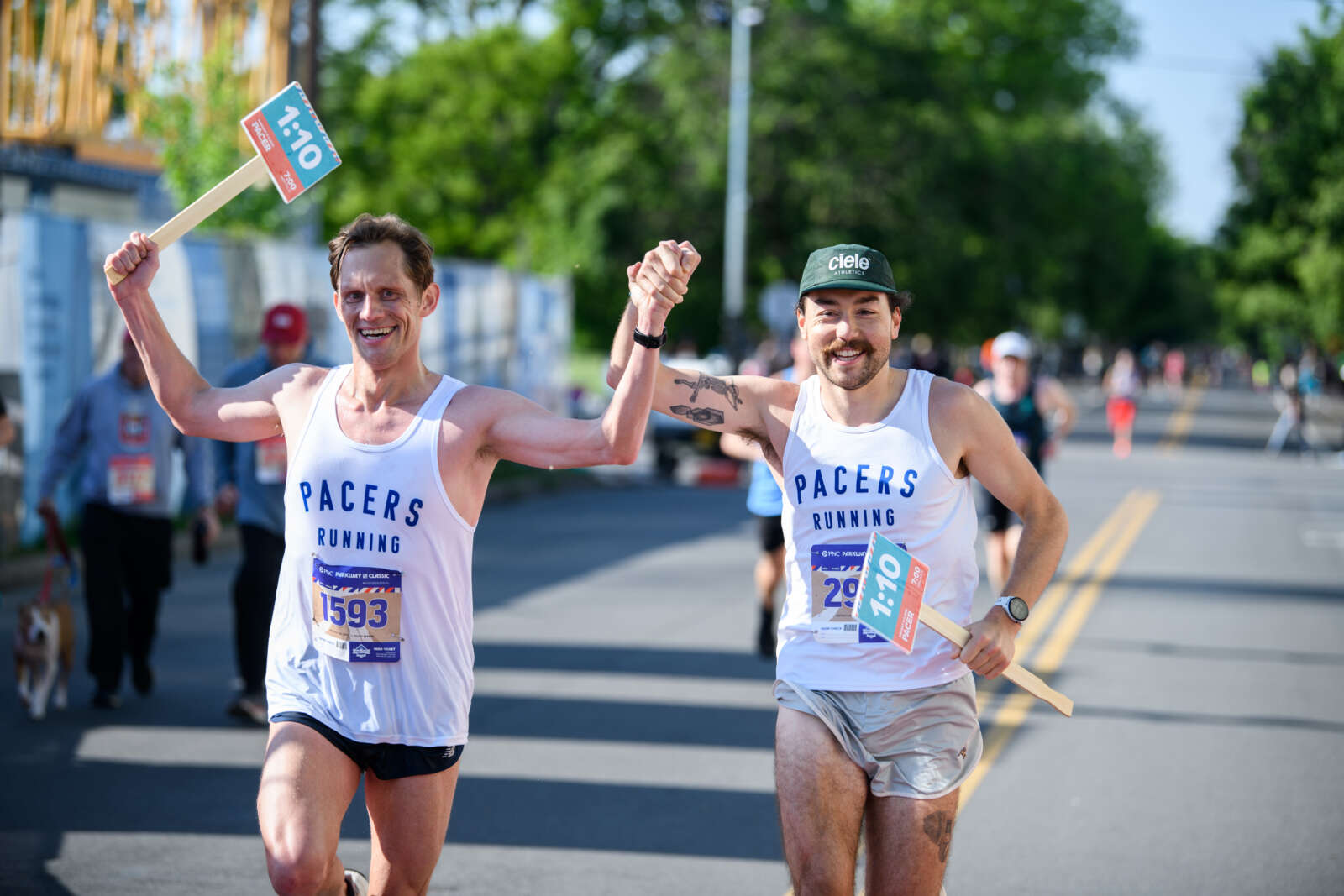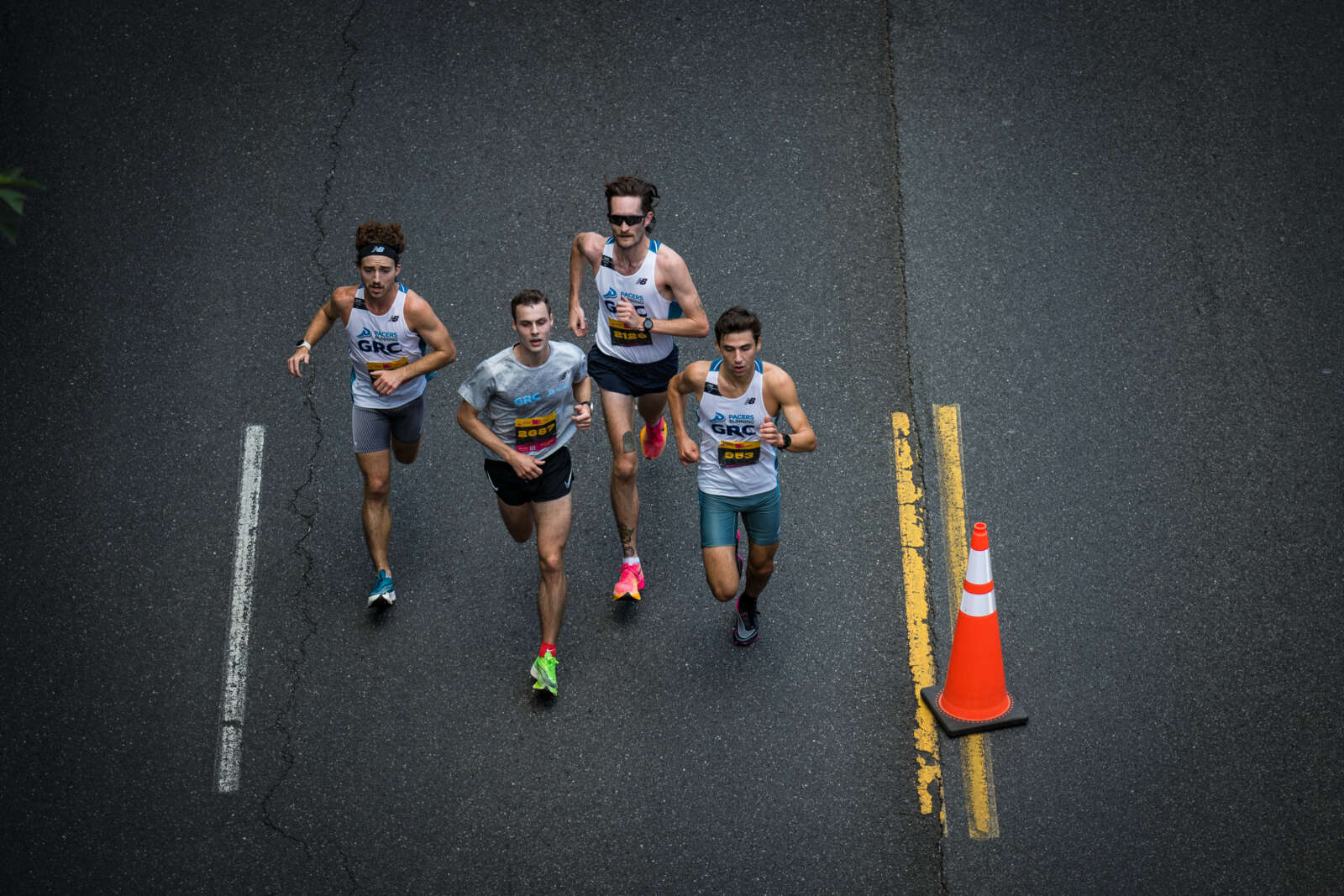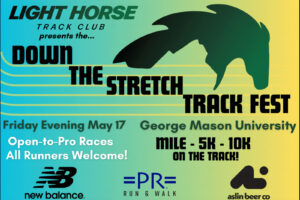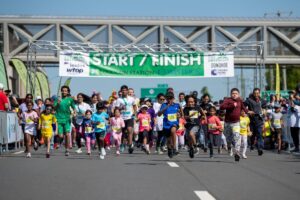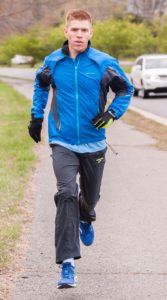
Matt Rodjom knows the paved paths along busy roads in Fairfax so well that he could run Braddock Road with his eyes closed.
Not that it would be much different, as he puts it.
He has a gaping hole in his vision, straight ahead. He can see the colors of an approaching runner’s shorts and t-shirt when they are 10 feet apart, but as far as he can tell, that other runner doesn’t have a head. Just a gray mess.
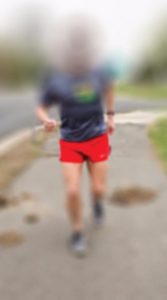
Leber’s Hereditary Optic Neuropathy took much of his vision over four months when he was 20 years old. At first, he thought he just needed glasses after he couldn’t read the license plate on the car ahead of him. Then it got much worse, leaving him with clear peripheral vision but not much else.
After a bad fall a few months later, his college athletic director told him that allowing him to compete in cross country would be a liability. Rodjom channeled his anger and frustration back into his running.
“I wanted to show everyone I could still do it,” he said. “They made me a coach so still I could be a part of the team, but I wanted to compete.”
He was, however, allowed to run for the track team, what was then a consolation prize.
As he settled into his new life and then graduate school, running became an outlet for stress relief. Then, when he moved to the D.C. area, helped him meet people. Now it’s a chance for him to show the running community what visually-impaired runners can do, and for him to find out for himself what he is capable of achieving.
Sixteen years after he was relegated to the track, that oval is Rodjom’s training ground as he vies for a spot on the U.S. Paralympic Track and Field competing in Rio de Janeiro right after the Summer Olympics. “My wife told me this would be my best chance to do this,” he said of Sarah, with whom he has twin five-year-old daughters and a two-and-a-half-year-old son. “I’m in the upper echelon of visually impaired runners and if I let this opportunity go, I’ll spend a lot of time wondering what I could have done.”
She has been chronicling his progress on her blog, Daddy’s Blind Ambition. The family’s lighthearted handling of his condition is pretty consistent. On one of their first dates, they went to a bookstore and he arbitrarily grabbed books and pretended to read them, which tipped her off that something wasn’t entirely right with his vision.
Roadmap
Getting to Rio means dropping almost 80 seconds off of his 5k time to hit the 15:40 standard. His marathon PR is much closer, in seconds per mile, to the standard, but even with a wife who prioritizes his training, there is too much to do in their lives for him to do the necessary marathon training.
“Looking at it realistically, it’s a big jump, but it’s one I’m ready to go after,” he said.
He does most of his running after work at the Department of Homeland Security, either hitting the track or a typically-empty parking lot on the George Mason campus after the kids are asleep, or logging miles on the treadmill in his basement, a compromise that “makes (him) feel a little dirty,” he said. “But it’s part of being a dad.”
He can cross streets safely — thanks in large part to his remaining peripheral vision — but if he sees a car’s headlights head on, he can lose most of his vision.
In the daytime, wearing a pair of Oakley sunglasses he found has saved him on more than one occasion, keeping him from having to squint in bright sunlight and lose more of his peripheral vision.
Sarah insists he carry his phone with him when he leaves the house to run, just in case, though the one time he called her for assistance — he was badly dehydrated — she was working late and couldn’t come home to get him a drink of water. He made it home alright.
“I’ve gotten lost a few times and had to ask Siri for directions back,” he said. “Usually, I just memorize Google Maps. I have a pretty good sense of direction and I haven’t had to ask anyone to get me home.”
The path so far hasn’t been as smooth as a track, though. Back when he met Sarah, he was on a three-month layoff after running into a fire hydrant. He can’t venture onto rocky trails, as he once did while a dedicated member of the D.C. Road Runners when he lived closer to the District. Running with groups could also be hazardous.
On the paved paths that crisscross Fairfax County, he can get his mileage in — he’s gone as far as I-95 — but now that he has turned his attention to a hitting a time goal, the track and parking lot are workplaces.
“If I’m running along the road at 5:40 pace, things come at me too fast,” he said. “I can’t be sure a bicyclist and I are going to dodge each other.”
He has teamed up with Reston-based coach and physical therapist Matt Barnes to help run faster.
“He’s pretty self-driven and motivated,” Barnes said. “I can’t be there to hold a stopwatch at the track but I know he’ll be able to take care of himself.”
Barnes said Rodjom’s strongest element, his turnover speed, will set him up nicely for championship racing when he needs to kick, but since they still have a ways to go to hit the qualifying standard — it was lowered dramatically — Barnes is swapping out some tempos, which he struggles with, for larger sets of intervals with less rest.
“He’s on pace to be running in the high 15s in a month and a half and with the right race at nationals (in late June in Charlotte) he could run in the 15:30s,” Barnes said. “We’re counting on this work coming together pretty soon.”
The Voices
Most electronics in the Rodjom household talk. So does the watch he wears when he runs, though he hasn’t been able to find a talking GPS watch yet.
Though Rodjom is focusing on the track, he likes to race on the roads, and that means doing more than turning left every 100 meters.
Visually impaired runners employ all kinds of strategies when they race, and all are on display at the Woodrow Wilson Bridge Half Marathon, where Rodjom finished 40th in 2012. The race plays host to the national visually impaired half marathon championship. While some runners tethered themselves to guides with a rope, bungee cord or a long sleeve shirt, Rodjom defiantly ran alone.
Two months later, while in Sacramento for the California International Marathon, blind runner Richard Hunter, told him in as many words that he was being stupid for eschewing a guide.
“I was being stubborn, but I wanted to prove I could do as much as any other runner, without any help,” Rodjom said. “That wasn’t even the reckoning point for me, though.”
It wasn’t until nearly a year later, after blowing right through a turnaround at the Race to End Women’s Cancer that he saw just how much he was handicapping himself. He swallowed his pride and contacted Jerry Alexander, coach of the Georgetown Running Club, who helped recruit guides to help visually impaired runners at the Wilson Bridge Half, to help Rodjom race some lower-profile 5ks.
“It was hard to find guides who can run under six-minute pace and give verbal commands,” Rodjom said. “There are Facebook groups and a networking site — United in Stride — but those are usually more for saying ‘I’m visiting D.C. and need a guide who can run with me.”
Ashburn’s Karl Dusen and Arlington’s Chuck Kacsur have come along for the ride.
“I pinged Jerry about a Valentine’s Day race on Friday and two hours later he came back to me with a guide,” Rodjom said.
He and Kacsur met 10 minutes before the Run Your Heart Out 5k and developed their system.
“Three, two, one turn,” Kacsur will say as they approach a turn.
Rodjom got his introduction to competitive visually impaired running while at his first job as a contractor with the Navy. He worked with another visually impaired runner, Joe Aukward, doing budget analysis.
“It was the blind leading the blind,” he joked, as Aukward served as both a professional and athletic mentor. “I was just trying to use running as a way to get to meet friends and he started encouraging me to compete again. There was nobody better to push me.”
The visually impaired running community has been a great support for him. He still dreams in full vision at times. Having to stop driving just four years after he got his driver’s license remains one of the toughest pills to swallow, but he is grateful for the perspective his experiences have lent him.
“Finding out you’re not alone out there, trying to keep doing this, that means a lot,” he said. “If someone offered me my sight back, I’ll be honest, I’d take it, but this whole experience has introduced me to some great people I wouldn’t have met otherwise.”
Recent Stories
Down The Stretch Track Fest
Down The Stretch Track Fest is a track celebration!
A distance-focused track meet at George Mason University featuring community-to-pro-level races on Friday evening, May 17th.
New Balance merch, Aslin Beer, music all night, and announcers keeping you up-to-date on the
Run the Greenway
We are just days away from the 4th annual Run The Greenway Race and
spots are filling up fast! We don’t want any Jedi to be left behind at this year’s
5K, 10K, or 800-meter Kids Fun Run, or virtual


